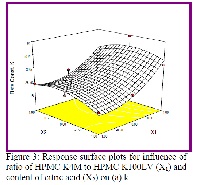Effect of formulation variables on the development of novel controlled release floating matrix tablets of cefixime
Keywords:
Cefixime, HPMC K 100 LV, HPMC K4M, HPMC K15M and HPMC K100MAbstract
The aim of this work is to study the influence of formulation parameters in the preparation of controlled release floating matrix tablets of Cefixime. A 32 full factorial experiment was designed to study the effects of the ratio of HPMC K4M to HPMC K100 LV (X1) and content of citric acid (X2). The results of factorial design indicated that ratio of HPMC K4M to HPMC K100LV had dominant role on drug release from floating matrix tablets compared to citric acid, although the presence of later component in formulation with optimum concentration is essential to improve the drug release of hydrophobic molecules of drug. The linear regression analysis and model fitting showed that all these formulations followed Korsmeyer and Peppas model, which had a higher value of correlation coefficient (r). Three dimensional response graphs were presented to visualize the effect of independent variables on the chosen response. For the development of controlled release dosage form for poorly soluble drug like Cefixime trihydrate, polymer blends of different viscosity grade of HPMC and presence of citric acid appears necessary, which imparts hydrophilic environment and to increase drug release, respectively.
References
Kees F, Lukassek U, Naber KG, Grobecker, H. Comparative investigations on the bioavailability of cefuroxime axetil. Drug Res. 1991; 41: 843-846.
Goodman and Gilman’s The pharmacological Basis of therapeutics. Eleventh edition. McGraw-Hill: Medical publishing division; 1807.
Yeole PG, Khan S, Patel VF. Floating drug delivery systems: Need and development. Indian. J. Pharm. Sci. 2005; 67: 265-272.
US pharmacopoeia 28. United state Pharmacopoeial convention. Rockville MD. USA. Asian edition, 2005; 2509.
US pharmacopoeia 28. United State Pharmacopoeial convention. Rockville, MD. USA. Asian edition, 2005;2745.
Patel VF, Patel NM, Yeole PG. Studies on formulation and evaluation of ranitidine floating tablets. Indian J. Pharm. Sci. 2005; 67: 703-709.
Carstensen JT, Drug stability: Principle and practices. Marcal Dekker. New York, USA, 2nd ed. 1995, 538-550.
Colombo P, Bettini R, Peppas NA. Observation of swelling process and diffusion front position during swelling in HPMC matrices containing soluble drug. J. Control Release. 1999; 61: 83-91.
Dow Chemical Co., Methocel: Cellulose ethers technical handbook. 1996; 18-20.
Costa, P., An alternative method to evaluation of similarity factor in dissolution testing. Int. J. Pharm., 220, 2001, 77-83.
Moore, J. W. and Flanner, H. H., Mathematical comparison of dissolution profiles, Pharm. Technol. 20(6), 1996, 67-74.





